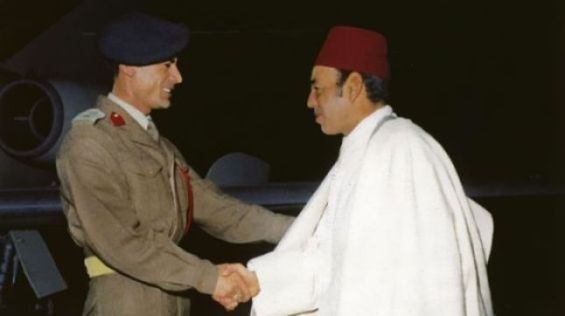On August 13, 1984, King Hassan II (1962-1999) and Libyan Colonel Muammar Gaddafi signed the Treaty of Oujda between Morocco and Libya, also known as the «Arab-African Union» agreement. Many Western countries were surprised by this rapprochement between a moderate king and a so-called extremist leader.
However, the agreement came after Gaddafi showed signs of moderation towards Morocco, including assurances that he had stopped supporting the Polisario Front fighters and their separatist claims. A CIA document dated November 30, 1984, declassified on April 4, 2011, states that Hassan II emphasized «Libyan financial assistance as a means to ease the country’s deteriorating economic and social conditions that sparked riots last January».
Entitled «Moroccan-Libyan Union: Status and Prospects», the document stresses that «the seating of the Polisario’s self-proclaimed republic at the recent OAU summit and Morocco's consequent withdrawal will encourage Rabat to continue the union as a useful way to eliminate Tripoli's support to the guerillas».
In return, according to the CIA, Gaddafi would attempt to «use Morocco as a middleman in obtaining restricted US-origin spare parts for aircraft and other equipment». The document states that the CIA expects «Hassan II to firmly resist any international pressure to disavow the union». «We believe that Hassan II wants to maintain close relations with the United States, but he would watch closely for signs that Washington is taking punitive action against him».
Algeria's role between the Polisario, Iran, and Syria
The CIA once viewed the Morocco-Libya Union as exacerbating political differences in North Africa, dividing the region into two blocs: Tunisia, Mauritania, and Algeria on one side, and Libya and Morocco on the other.
US intelligence noted that Algeria saw «the union as a tactical move by Hassan II to block Algerian efforts to promote regional unity and end the Western Sahara conflict». For Algiers, «the union would also encourage Gaddafi's efforts to destabilize the region».
The document mentions Algeria's wish to see tensions undermine the alliance. The eastern neighbor «would move cautiously to encourage its early demise [of this rapprochement]». The document suggests that Algeria was aware of «the personal incompatibilities between Gaddafi and Hassan II» and anticipated that these differences would erode the «marriage of convenience».
Algeria also used the union to isolate Libya from its regional partners known for their anti-Western positions. In discussions «with Iran, Syria, Lebanon, and radical PLO factions, Algerian officials cited the union as an indication that Gaddafi was not a reliable ally».
This union also pushed Algeria into a harder stance on the Western Sahara question. The American intelligence agency considered that Algiers had «the option of providing the Polisario guerillas with new weapons systems or it can intervene selectively by providing Algerian tactical air support».
Furthermore, the document indicates that Algeria could respond by shoring up «international diplomatic support on Western Sahara», particularly «by encouraging contacts between Polisario fighters and Syria and Iran». Tehran recognized the pseudo-«SADR» on February 27, 1980, followed by Damascus on April 15, 1980. However, neither capital established deep diplomatic relations with the separatist front.
Shimon Peres' visit to Morocco heralds the end of the union
The American agency confirmed that the union would progress as long as Muammar Gaddafi provided «economic support, backed Morocco on the Western Sahara, and continued to privately profess moderation in their bilateral relationship». According to the same source, Rabat's handover of Libyan dissidents to Colonel Gaddafi was a further determining factor in the longevity of this bipartisan alliance.
The CIA also believed that Gaddafi's failing to keep his promises to Morocco could prompt Hassan II to put an end to this union. It added that the Libyan leader «would try to involve Hassan II in his radical stance against the United States and Israel».
Regarding the implications of the union for the United States, the document confirmed that «Hassan II almost certainly calculated that a union agreement would cause some cooling in his relationship with the United States». «He maintained close relations with the United States and had no illusions about transforming Gaddafi's errant behavior», the document stated.
However, the same source added that the king «believed that he could control the direction of the union. At the same time, he would be watching closely for indications that Washington wanted to redefine its relationship with Morocco».
As for possible options for King Hassan II, in the event of sanctions from Washington, according to the agency, they included «reducing or stopping visits by US naval ships and US military exercises», or «refusing to allow US forces to use Moroccan facilities», under an agreement between the US and Morocco.
These measures also included shutting down the «Voice of America operations in Morocco», «adopting a more radical stand on Middle East issues», and «turning to Libya and the Soviet Union for military assistance».
In the end, this union had a shorter lifespan than expected. In July 1986, two years after signing the Morocco-Libyan treaty, Hassan II unilaterally announced the end of the agreement. The reason: Muammar Gaddafi described the Moroccan king's reception of Israeli Prime Minister Shimon Peres as «high treason».




 chargement...
chargement...












